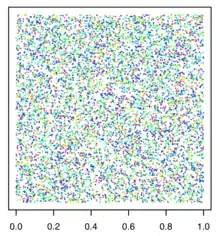MIXMAX generator
The MIXMAX generator is a family of pseudorandom number generators (PRNG) and is based on Anosov C-systems (Anosov diffeomorphism) and Kolmogorov K-systems (Kolmogorov automorphism). It was introduced in a 1986 preprint by G. Savvidy and N. Ter-Arutyunyan-Savvidy and published in 1991.[1]
 | |
| Class | pseudorandom number generator |
|---|---|
| Data structure | Array |
| Worst-case performance | O(n) |
| Best-case performance | O(n) |
| Average performance | O(n) |
| Worst-case space complexity | O(n) |
A fast implementation in C/C++ of the generator was developed by Konstantin Savvidy.[2] The period of the generator is and the Kolmogorov entropy is for the matrix size .[3] That generator occupies less than 2 kb, and if a smaller generator state is required, a N = 17 version with less than 200 bytes memory requirement also exists.
The generator works on most 64-bit systems, including 64-bit Linux flavors and Intel Mac. It has also been tested on PPC and ARM architectures. The latest version also runs on 32-bit systems and on Windows. The generator is equally usable with C++ programs, has been chosen as the default generator in CLHEP[4] for use in Geant4[5] and there exists a ROOT interface.[6] It has been recently tested extensively on very wide variety of platforms, as part of the CLHEP/Geant4 release.
An analysis by L’Ecuyer, Wambergue and Bourceret,[7] see also,[8] showed that MIXMAX generators, just as all other Multiple Recursive Generators and linear congruential generators, has a lattice structure and that the produced random numbers, when considered as coordinate in a n > N - dimensional space, lie on a set of parallel hyperplanes and determined the maximum distance between the covering hyperplanes.
References
- Savvidy, G.K; Ter-Arutyunyan-Savvidy, N.G (1991). "On the Monte Carlo simulation of physical systems". Journal of Computational Physics. 97 (2): 566. Bibcode:1991JCoPh..97..566S. doi:10.1016/0021-9991(91)90015-D.
- K. Savvidy (2015). "The MIXMAX Random Number Generator". Computer Physics Communications. 196: 161–165. arXiv:1403.5355. Bibcode:2015CoPhC.196..161S. doi:10.1016/j.cpc.2015.06.003.
- K. Savvidy and G.Savvidy (2015). "Spectrum and Entropy of C-systems MIXMAX Random Number Generator". Chaos, Solitons and Fractals. 91: 33–38. arXiv:1510.06274. Bibcode:2016CSF....91...33S. doi:10.1016/j.chaos.2016.05.003.
- "CLHEP". proj-clhep.web.cern.ch.
- "Geant4". proj-clhep.web.cern.ch.
- "ROOT - ROOT::Math::MixMaxEngine Class". root.cern.ch. Retrieved 2016-04-09.
- Pierre L’Ecuyer, Paul Wambergue, and Erwan Bourceret (September 22, 2017). "Spectral Analysis of the MIXMAX Random Number Generators" (PDF). Cite journal requires
|journal=(help)CS1 maint: multiple names: authors list (link) - N.Martirosyan, K.Savvidy, and G.Savvidy (Nov 19, 2018). "Spectral Test of the MIXMAX Random Number Generator". Chaos, Solitons and Fractals. 118: 242–248. arXiv:1806.05243. doi:10.1016/j.chaos.2018.11.024.CS1 maint: multiple names: authors list (link)